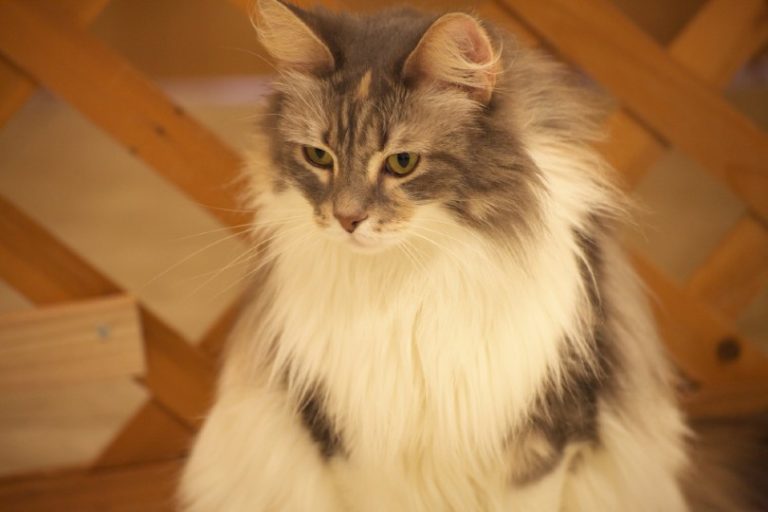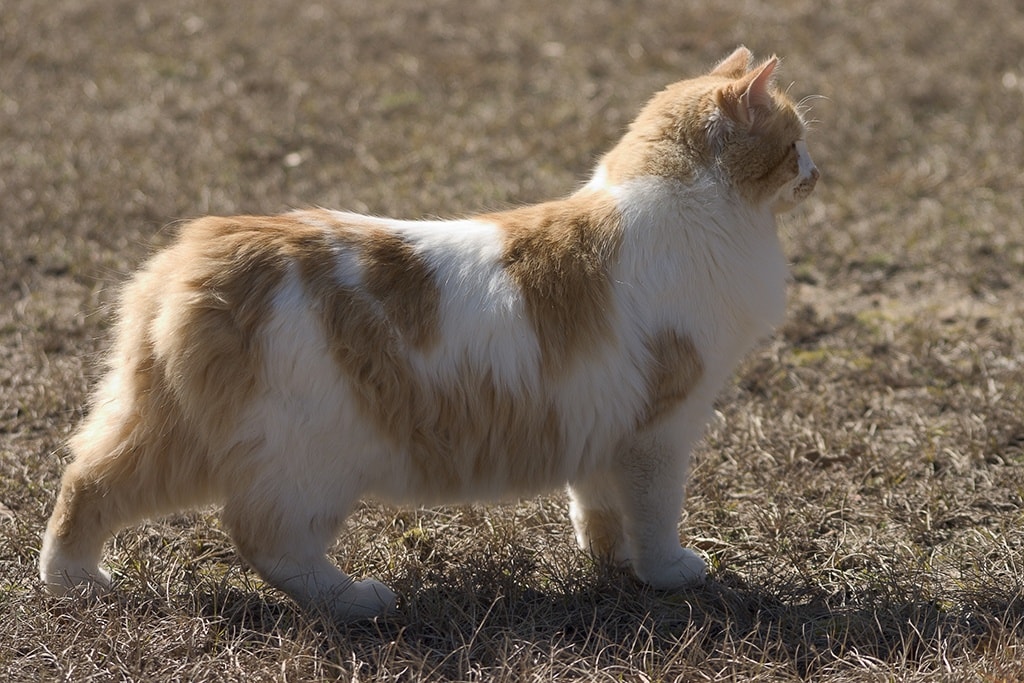
Click Below to Skip Ahead
Cymrics are one of those cat breeds that are instantly recognizable thanks to their complete lack of tail. While this unique characteristic sets it apart from other breeds, the Cymrics’ personality is the breeds’ crowning jewel.
Breed Overview
Height:
7 – 9 inches
Weight:
8 – 12 pounds
Lifespan:
8 – 14 years
Colors:
White, blue, black, red, cream, silver, tortoiseshell, blue-cream, brown
Suitable for:
Families with children and multi-pet households
Temperament:
Loyal, adaptable, easygoing, affectionate
These cats are known for their affectionate, loyal, and adaptable nature, making them a great pick for families and multi-pet households.
If you’ve been looking for a new kitty to adopt, keep reading to learn if a Cymric will be the right fit for your family.
Cymric Characteristics
 Cymric (Manx Longhair) Kittens
Cymric (Manx Longhair) Kittens
If you’d like to adopt a Cymric kitten, you’ll want to do some research to find the best and most reputable breeder in your area. A purebred Cymric kitten will range in price, depending on its lineage and the breeder.
You might get lucky and find a Cymric available for adoption at a local shelter, but the chances of this happening are rare. If you’re able to find one at your shelter, the adoption price should be much less.
Temperament & Intelligence of the Cymric
Cymric cats are very interactive and thrive in environments with other people and pets. They are intelligent and easygoing and aren’t typically a demanding breed.
They can entertain themselves if their humans are out of the house and don’t tend to get upset about too many things. While they can fend for themselves, they still love people and make great companions. They sometimes choose a favorite family member that they’ll bond with and follow around the house. Cymrics make great lap cats and will even “talk” to you in their own special language.
Cymrics were mousers in their early days and still retain their useful hunting skills in modern times. They are protective of their family members and sometimes act as the “watch cat” of the home, growling or attacking sights or sounds out of the ordinary.
Cymrics are fascinated with water. Perhaps this fascination is born out of their beginnings on the Isle of Man. Either way, you might find your kitty playing in the toilet water or running to check out what you’re doing in the kitchen sink.
Are These Cats Good for Families? 👪
Cymrics are a very popular pick for families. This breed is known for its loyalty and playfulness, making it a great choice for households with children. If your Cymric is introduced to small children during kittenhood, he’ll have no problem adapting to living with kids.
As long as you teach your kids boundaries and how to play with them safely and responsibly, they should get along just fine. Some cats will bond with one person in their family, while others have plenty of love to go around, giving it equally to every member of their family.
Does This Breed Get Along with Other Pets?
Another great thing about this breed is how easygoing it is with other pets. Cymrics can live harmoniously with other cats and even dogs. His high level of trainability means you can teach him to leave other pets like birds or fish alone, too.
Be sure to introduce new pets to each other slowly. Doing introductions too quickly can lead to stress, anxiety, and fights.
 Things to Know When Owning a Cymric (Manx Longhair):
Things to Know When Owning a Cymric (Manx Longhair):
There’s a lot more to cat ownership than you might first think. You should familiarize yourself with the diet, exercise, and grooming requirements, as well as any health conditions you should be on the lookout for. Keep reading to learn all of the things you’ll need to know before adopting a Cymric.
Food & Diet Requirements 
A Cymric’s diet needs to support its high activity level while not promoting obesity. As with any other cat breed, feline obesity is a real concern so it’s essential to ensure you’re not overfeeding your kitty.
Feed your cat measured amounts of their food at regular meal times throughout the day. Find a feeding schedule that works best for your lifestyle. Free-feeding might be convenient, but it can cause your kitty to snack all day long, which can eventually cause obesity.
Exercise 🐈
Cymrics are powerful jumpers with a lot of energy. They need a home that has plenty of high places to perch so they can practice their jumping and climbing while also keeping an eye on the house. Make sure you have a sturdy cat tree that they can traverse.
They can learn to play fetch and enjoy carrying their toys around the house. Help your kitty get more exercise in his day by having a variety of fun and engaging toys like feather wands or balls to play with.
Training 🧶
Cymrics are very intelligent cats who can learn tricks and commands like fetch and come. If you teach them early, it’s often easy for them to learn how to walk on leashes, too.
Cymrics don’t mind car rides, making them a great road trip companion. This might be another thing you’ll need to teach them when they’re younger, though, as older cats tend to get set in their ways.
This breed can learn how to open doors so that’s something to keep in mind. You might want to keep doors locked to prevent him from escaping.
It’s easy for Cymrics to learn boundaries—provided you start setting them early. They will usually respect your wishes when you tell them ‘no’ or request they get off the cupboard or bed.
Grooming ✂️
Cymrics have a double coat that needs daily attention. You should be willing to set aside time every day to give them a good brushing to keep their coat smooth. Their undercoat will build up over time if you don’t brush them regularly. You may need to do additional grooming during the shedding seasons because of the thickness of their coat.
Don’t forget to take care of your kitty’s ear and nail needs, too. Trim their nails once a week and their ears when necessary.
To keep your Cymric’s teeth in tip-top shape, aim to brush them a few times a week.
Health and Conditions 🏥
While the tailless-ness is what makes a Cymric (and other Manx cats) unique, it could be a potential health hazard as it’s not always benign. In fact, the gene that causes the tailless-ness in Cymrics can be lethal in some situations. Sometimes kittens will inherit two copies of the gene but they will die before birth and get reabsorbed in the womb. Around 25% of kittens will inherit two copies of the gene which results in small litter sizes.
Sometimes kittens who only inherit one copy of the gene can develop a condition called Manx syndrome. This condition can cause spina bifida, fused vertebrae, gaps amongst the vertebrae, and even bowel or bladder dysfunction. Other neurological symptoms like partial paralysis and seizures aren’t uncommon in Manx cats.
Arthritis and corneal dystrophy are two other conditions that this breed seems to be pre-dispositioned for.
As with any other cat breed, your Cymric will need regular vet check-ups and vaccinations to stay his healthiest.
Male vs Female
Males tend to be on the heavier side, weighing in at 12 pounds or more, while females are usually between 8 and 12 pounds. Aside from size, there doesn’t seem to be much of a difference between male and female Cymric cats.
As with most other cat breeds, males may be prone to behaviors like spraying. Many of these behavioral issues can be fixed by getting your male cat neutered.
3 Little-Known Facts About the Cymric
1. A Genetic Mutation Caused the Manx Tailless-ness
The Manx cat originated in the Isle of Man, though the long-haired variant is said to have been developed in Canada. According to records from the Isle of Man, a genetic mutation is to blame for the Manx breed not having a tail. Since the island has such a small population, the gene pool was small, so it wasn’t difficult for the dominant gene that causes the tailless-ness to pass from generation to generation.
2. Long-Haired Manx Were Originally Thought to Be Mutants
Long-haired Manx kittens have been born on the Isle of Man but breeders would discard them as they thought they were mutants. It wasn’t until the 1960s that Canadian Cymric breeders began breeding them intentionally.
While Cymrics are often considered to be a new breed by cat fanciers, historians agree that the long-haired Manx has been around as long as the short-haired variety.
3. Not All Cymrics Are Tailless
While their missing tail is generally thought to be the defining physical characteristic of any Max cat, not all Cymric cats are tailless. The Isle of Man Longhair is a Cymric cat with a tail. Currently, only the New Zealand Cat Fancy registry recognizes them as a separate breed. Other international registries refer to these cats as “Tailed Cyrmcis” or “Tailed Manx Longhair”, and they’re only recognized as breeding stock and are not able to become show cats.
 Final Words
Final Words
Cymrics are a beautiful breed with many winning personality traits. They can be more prone to certain serious health conditions than other breeds, however. If you’re considering adopting a Cymric, you might choose a slightly older kitten as many of the health conditions they’re prone to will start to show symptoms during the early months of the kitten’s development.
Featured Image Credit: applevinci, Shutterstock

 Cymric (Manx Longhair) Kittens
Cymric (Manx Longhair) Kittens Things to Know When Owning a Cymric (Manx Longhair):
Things to Know When Owning a Cymric (Manx Longhair):




